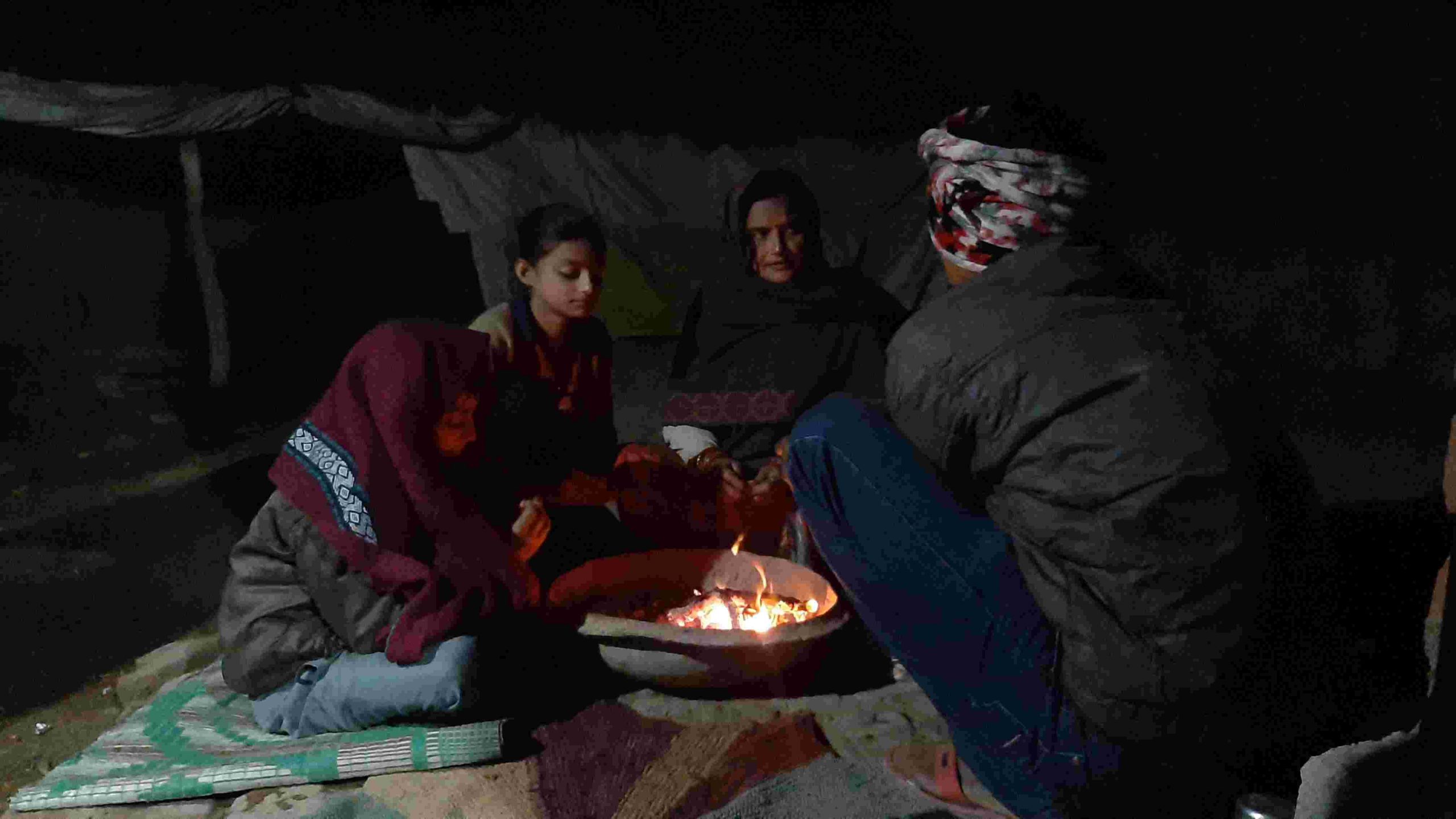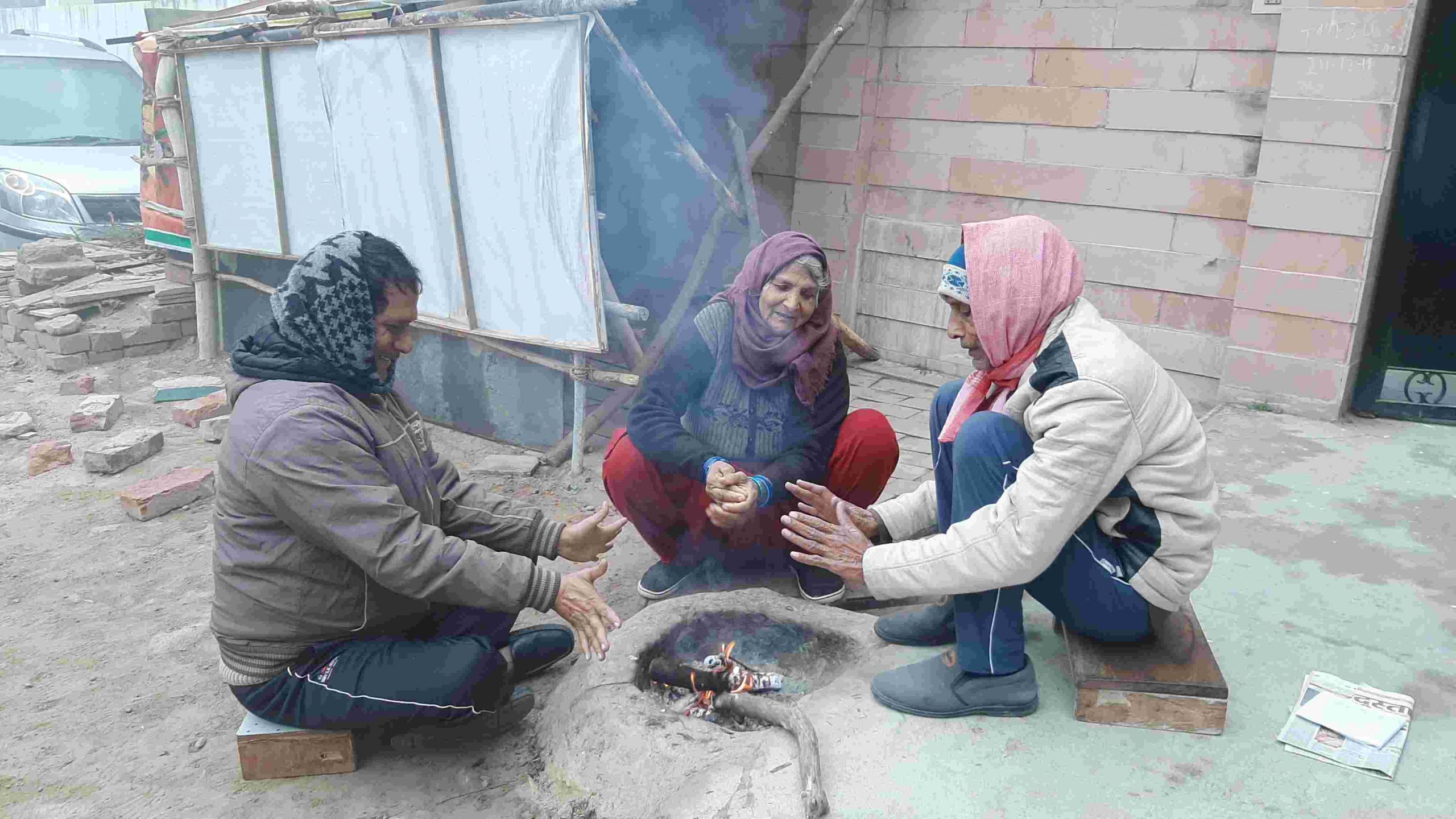Winter bonfires were once popular in rural areas. Now, mobiles have taken over
A happy crowd surrounding a bonfire, narrating stories late into the night, savouring baked and sweet potatoes and other earthy winter dishes are now sweet nostalgic memories of the past. Now, people sit covered in a quilt with mobile phone in hand

“A huge crowd used to gather around these bonfires before the advent of mobile phones and TV. Now, since each one of us sits covered in a quilt with mobile phone in hand, who has the time to listen to stories,” said Dinesh Katiyar, 45, warming himself by the bonfire.
Five-six years ago, when things such as mobile phones had not taken over our lives, bonfires used to be the wintertime hubs of entertainment in rural areas. While escaping from the chill of the winter, people used to enjoy themselves through folk music, singing and storytelling along with these bonfires. Besides, scores of issues got sorted and mutual help used to be arranged here. People also used to discuss rural crop issues while enjoying baked potatoes and sweet potatoes.
“Since six-seven years, the charm of bonfires and storytelling has waned. Bonfires not only provided much-needed relief from cold but also provided for the village entertainment. Here, one could easily learn about the entire village’s happening. Now such things don’t happen,” said Dinesh, a resident of Nindapur village in rural Kanpur.
Trying to light up a bonfire amid deep fog at morning seven o’clock, eighty-year-old Sudama Prasad Akela’s fingers shook.
“This fire provides the sole comfort to my old bones in such harsh weather. Bonfires are today lit like before, the difference being in their location. Previously, they used to be communal and so were situated at the village intersection. Now they are individual and so are created outside people’s doorsteps,” Sudama Prasad speaks while busying himself in warming up his fingers. Such was the scene in Nainpur village of Rajpur block, which is about 45 km from Kanpur rural district headquarters.
Several households had similar bonfires lit in front of their doorsteps. By each bonfire sat a small group of people warming up. After a while, few more people joined Sudama. When asked whether such bonfires were previously arranged as well, Sudama replied, “Village is not the same anymore. Previously, people used to be awake all night listening to stories. People used to light up bonfires as soon as the sun went down with crowd filtering in to join the gathering.”

In rural India, villagers with limited resources are provided much-needed relief from the cold by the bonfires. However, due to modernization, the bonfires are now limited to individual doorsteps. Previously, if some household’s food grains fell short before the new crop’s arrival, it needn’t have bought them, somebody at the village bonfire used to readily help out. Now the villages do not have such a strong feeling of brotherhood.
‘He Bharat ke annadata ye kesi behali re/Sara jag ka pet bhare tu, teri jholi khali re…,” (O India’s foodgiver, what is this predicament?/ You feed the entire world and yet remain deprived) sitting by the fire, Sudama sang many folk songs pertaining to farming which he had penned himself.
Our country also has a religious significance of bonfires. In Odisha, bonfires are lit in observance of the Agni Purnima festival on the full moon of the second month of the Hindu calendar which falls in the middle of February. A day prior to Makar Sakranti, people from the Sikh community celebrate the festival of Lohri. The festival is celebrated with much fanfare in Haryana and Punjab by lighting bonfires. People gather twigs and logs of wood into a pyramid-shaped structure and perform puja offering sesame, sweets, sugarcane, rice and fruits to the fire. Thereafter, people perform gidda and bhangra to the tune of dhols (drums).
Sitting by some other bonfire at a small distance, storyteller Rajesh Kumar, 55, said: “Five years ago, when I used to tell stories, all the kids of the neighbourhood used to gather around me and listen to my stories for hours. Ever since this mobile thing has come, the children sit on it chitchatting the whole time. Kids busy themselves in games while grownups are engaged with WhatsApp and YouTube. No one has time to listen to stories now.”
Like Rajesh and Sudama, every village had 2-4 people who used to be storytellers and folk singers. These used to be in great demand during the winters with everyone wanting them to perform at the bonfire in one’s locality. Such people are still there in the villages, but their audience is waning due to the impact of technology.
“Though the technology may have eased our lives, it has weakened our brotherhood. Now people do not sit together at bonfires anymore. Previously, people fond of listening to stories used to arrange firewood in front of their doorsteps,” said Rajesh, adding: “These stories were about kings and queens, fairies, King Vikramaditya, Panchtantra, etc. “
Previously, it was a norm to light bonfires at village intersections. Come winters and bonfires were lit. There were constant bonfires for two-three months and it was the responsibility of each person to help in arranging the firewood and maintaining its uninterrupted supply. The crops that grew during winter were largely consumed by the villagers and provided them warmth.

Sitting beneath a neem tree in the wee hours of the morning, 65-year-old Devi said: “In our times, people used to begin manual milling even before daybreak. They used to prepare animal feed and water the fields late into the night. Everyone used to work so hard that one hardly felt the cold. Now no matter how well we are covered or we keep ourselves warm, we still shiver from the cold.”
Wiping off her eyes bleary due to smoke, Devi said: “People used to make things such as bajra, jowar, sesame and flaxseed laddus, dried ginger gur which used to provide warmth to the body. People ate and wore hardy stuff and so could face harsh winter but it isn’t so now.”
The villagers used to spread paddy straws for the night as bedding. Every member of the house used to sleep over this, at a few places, it is still done so. Villagers still put jute bags over the animals to protect them from cold.
Nine-year-old Rudra who lives in Nigoha village of Kanpur’s Chaubepur Block recited Shiv Stuti while warming himself by the bonfire. He said: “I have known Shiv Stuti and Hanuman Chalisa since I was four. My Baba (grandfather) used to seat us beside him by the fire and used to recite us such verses so that we may not run away.” He passed away two years ago so, remembering him, Rudra said: “I miss my Baba very much. Whenever he had the bonfire going, he’d call upon every passerby to join him. In the past, our doorstep used to be full of people during winters but no one comes now.”
Siddhan Devi, 45, frying potato kachauris over her earthen stove, said: “Previously, throughout winters, we used to make bathua paranthas, sarson saag, makka and bajra roti. Everyone was poor so people used to relish these preparations but today’s children do not like to eat such things.”
“People do not come forward to arrange the firewood, forest cover has thinned and wood is costlier so people are not able to buy wood for the purpose of bonfires. Everyone lights up a small individual fire. Today’s generation is quite intolerant so, if at all, few gather around some bonfire, they begin quarreling at the slightest of matter,” said Aniruddh Sharma, 50, a resident of Beri Dariyav village in Maitha block, which is about 50 kms from Kanpur rural district headquarter.
Sudama Prasad said: “Since the time people from the village began moving towards the cities, they started behaving like city folks and keeping to themselves. Previously, each considered neighbour’s woe as one’s own but now no one is bothered. Bonfires also brought the community together but they too have lost their charm.”

